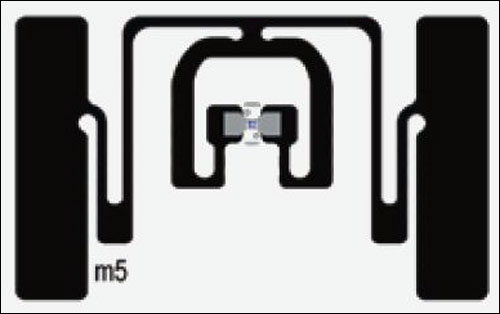May 02, 2014Avery Dennison's Retail Branding and Information Solutions (RBIS) division has released a broad range of new EPC ultrahigh-frequency (UHF) tags intended to expand the use of item-level RFID to products that have not previously been tagged, such as cosmetics, jewelry and cookware. The company also aims to broaden the use cases for apparel, by providing tags with smaller form-factors than existing UHF Gen 2 RFID apparel labels.
The new tags are part of Avery Dennison's approach to helping retailers, manufacturers and logistics providers adopt RFID at the item level to better manage all of their goods, not just those that are easy to tag, explains William Toney, Avery Dennison RBIS' head of market development for global RFID. He calls the approach "category enablement."

The tags were released just prior to last month's RFID Journal LIVE! 2014 conference and exhibition, held in Orlando, Fla.
In the long run, Toney says, Avery Dennison expects to provide tags that are more universal and can be placed on nearly every apparel item, as well as some other retail items within a store. The AD-320u7—which the company released last year (see Avery Dennison's New Tags Target Challenging Use Cases)—is one example of such a tag, but it still cannot be applied to every apparel item. As the firm continues to work on developing a truly universal apparel tag, he adds, it will also offer a range of specialty tags in a variety of form factors, with the goal of bringing RFID-tagging to most of a store's goods.
The AD-320u7, Toney reports, is a tiny tag designed for apparel items that may be too small to be easily tagged via standard UHF tags already on the market. Measuring 1.63 inches by 0.63 inch (41.4 millimeters by 16 millimeters) as an inlay and 1.75 inches by 0.75 inch (44.5 millimeters by 19 millimeters) as a converted label, the tag is made with NXP Semiconductors' Ucode 7 chip, and was designed to meet the University of Arkansas RFID Research Center's categories for denim, polybagged apparel and hanging apparel. The AD-320u7, Toney says, is the smallest tag to gain approval from the center's Arkansas Radio Compliance (ARC) laboratory across such a broad spectrum of categories.
Aimed at the cosmetics and jewelry markets is the new AD-172u7 tag—which, according to Toney, was developed for high performance when interrogated by a handheld reader, and has been optimized, tested and qualified by customers to meet that requirement. This tag is currently in use in retail environments for fashion and fine jewelry. Its inlay size is 0.87 inch by 0.49 inch (22 millimeters by 12.5 millimeters), while the label is sized at 31.75 millimeters by 15.49 millimeters (1.25 inches by 0.6 inch).
The new AD-160u7 was developed for another challenging product category for RFID tags: cosmetics, which tend to have small form-factors and are packed in a high-density environment. The tag is narrow in width and is designed for placement on lipstick tubes and eyeliner pencils, Toney says, and has been tested and qualified by a major vertical retailer that has asked to remain unnamed. It is intended for any cosmetics packaging with limited space, he adds, and provides strong performance on bottled liquids and lotions. The inlay measures 2.36 inches by 0.158 inch (60 millimeters by 4 millimeters), while the label measures 64 millimeters by 6 millimeters (2.5 inches by 0.2 inch).
The new AD-180u7 is another tag targeting cosmetics—in this case, eye shadow and products in cylindrical packaging—with an inlay diameter of 1.02 inches (26 millimeters) and a label diameter of 29.2 millimeters (1.1 inch). All three specialty tags are made with the Ucode 7 chip.
The new AD-381m5 tag comes with an Impinj Monza 5 IC, and its inlay measures 1.97 inches by 1.18 inches (50 millimeters by 30 millimeters). It is designed for attachment to the soles of shoes, for such use cases as in-store shelf displays. The risers built onto display shelves can interfere with RFID tag transmission, Toney says, but the AD-381m5 tag is designed to be easily read at such an angle, and to provide a form-factor that accommodates the dimensions of any shoe's sole.
The new AD-383u7 includes the Ucode 7 chip and is designed to be a multi-purpose apparel tag. The inlay measures 1.97 inches by 1.18 inches (50 millimeters by 30 millimeters) and, like all of the tags, operates at -40 to +185 degrees Fahrenheit (-40 to +85 degrees Celsius). The new AD-806u7 inlay, which measures 0.63 inch by 0.63 inch (16 millimeters by 16 millimeters) and has the Ucode 7 chip built into it, is designed for small apparel or other retail or health-care items. The new AD-226iM, a longer inlay at 3.74 inches by 0.32 inch (95 millimeters by 812 millimeters), made with NXP's Ucode G2iL chip, is a general-purpose inlay with extended memory (256 bits) that could be used for returnable transport units, as well as on apparel or other retail items.
All of the new tags are being piloted by retailers, Toney says, but those companies have asked not to be identified. The tags join the ranks of Avery Dennison's AD-451m5 on-metal tag, released last year (see Avery Dennison's New Tags Target Challenging Use Cases), designed for use with retail items such as kitchenware, including pots and pans, when the metal item itself is tagged—for example, kitchenware placed on display at a store. The inlay, which measures 1.97 inches by 1.18 inches (50 millimeters by 30 millimeters), is made with the Monza 5 chip. However, Toney notes, a standard UHF RFID tag could be applied to the packaging of such metal items.
The latest tag offerings, Toney adds, will bring RFID-tagging capability to retailers beyond the apparel sector. The apparel industry is expanding its use of RFID for tracking goods at a much higher rate than most other retail sectors, he explains, and the new offerings are designed to provide tags for those other items that have not previously been tagged.


